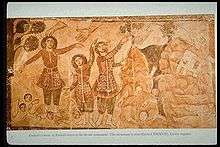Bath ḳōl

In Judaism bat kol or bath ḳōl (Hebrew: בּת קול, literally daughter of a voice, "voice of God") is a "heavenly or divine voice which proclaims God's will or judgment."[1] It signifies the ruach ha-kodesh (רוח הקודש, "the spirit of holiness") or serves as a metonym for God; "but it differed essentially from the Prophets", though these were delegates or mouthpieces of ruach ha-kodesh.[1]
In Art it is represented by the Hand of God.
Jewish Bible
The characteristic attributes of the voice of God are the invisibility of the speaker and a certain remarkable quality in the sound, regardless of its strength or weakness. A sound proceeding from some invisible source was considered a heavenly voice, since the mass revelation on Sinai was given in that way in Deuteronomy 4:12: "Ye heard the voice of the words, but saw no similitude; only ye heard a voice". In this account, God reveals himself to man through his organs of hearing, not through those of sight. Even the prophet Ezekiel, who sees many visions, "heard a voice of one that spoke" (Ezek 1:28); similarly, Elijah recognized God by a "still, small voice," and a voice addressed him (I Kings 19:12–13; compare Job 4:16); sometimes God's voice rang from the heights, from Jerusalem, from Zion (Ezek. 1:25; Jer 25:30; Joel 3:16–17; Amos 1:2, etc.); and God's voice was heard in the thunder and in the roar of the sea.[1]
Talmud
In the period of the Tannaim (c 100 BCE-200 CE) the term bath ḳōl was in very frequent use and was understood to signify not the direct voice of God, which was held to be supersensible, but the echo of the voice (the bath being somewhat arbitrarily taken to express the distinction). The rabbis held that bath ḳōl had been an occasional means of divine communication throughout the whole history of Israel and that since the cessation of the prophetic gift it was the sole means of Divine revelation. It is noteworthy that the rabbinical conception of bath ḳōl sprang up in the period of the decline of Old Testament prophecy and flourished in the period of extreme traditionalism. Where the gift of prophecy was believed to be lacking – perhaps even because of this lack – there grew up an inordinate desire for special divine manifestations. Often a voice from heaven was looked for to clear up matters of doubt and even to decide between conflicting interpretations of the law. So strong had this tendency become that Rabbi Joshua (c. 100 CE) felt it to be necessary to oppose it and to insist upon the supremacy and the sufficiency of the written law.
The last nevi'im ("spokespersons", "prophets") mentioned in the Jewish Bible are Haggai, Zechariah, and Malachi, all of whom lived at the end of the 70-year Babylonian captivity. The Talmud (Sanhedrin 11a) states that nowadays only the "Bath Kol" exists.
Art
In Jewish art the Bat Ḳol was often represented by the Hand of God, as in the Synagogue of Dura-Europas.
Literature
Josephus (Ant., XIII, x, 3) relates that John Hyrcanus (135–104 BCE) heard a voice while offering a burnt sacrifice in the temple, which Josephus expressly interprets as the voice of God.[2] According to Hebrew traditions, Metatron − an archangel and God's celestial scribe − is called the "Voice of God".
References
- 1 2 3 The Jewish Encyclopedia: BAT ḲOL: Kohler, Kaufmann; Blau, Ludwig. "BAT ḲOL". JewishEncyclopedia.com - The unedited full-text of the 1906 Jewish Encyclopedia. JewishEncyclopedia.com. Retrieved 10 February 2016.
- ↑ This article incorporates text from the International Standard Bible Encyclopediaarticle "Bath Kol", a publication now in the public domain.